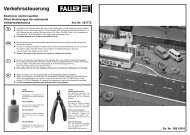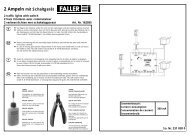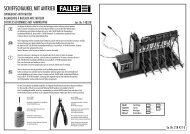INSTRUCTION MANUAL
INSTRUCTION MANUAL
INSTRUCTION MANUAL
You also want an ePaper? Increase the reach of your titles
YUMPU automatically turns print PDFs into web optimized ePapers that Google loves.
Decoder MX620 - MX622, MX630 - MX632 Sound Decoder MX640 - MX648 Page 59<br />
9 Predefined CV - Sets<br />
The following described CV sets are available from software version 27.0, but only in non-sound<br />
decoders, like the MX620, MX621, MX630, MX631 and MX632. More CV sets will be added with future<br />
software versions.<br />
There are no CV sets available for sound decoders (at least not until July 2010); the corresponding<br />
task is performed by CV lists within the sound projects.<br />
CV sets are prepared lists of CV values that are embedded in the decoder software; when desired,<br />
one of these lists can be activated by a "pseudo-programming" of CV #8.<br />
Decoders delivered as “normal” decoders don’t have any of the existing lists activated. All CV’s<br />
contain the normal values as shown in the CV tables as default. However, an existing CV set can be<br />
activated with the “CV #8” procedure (see below).<br />
Decoders delivered as “OEM” decoders, i.e. decoders installed by the loco manufacturer, usually<br />
have the correct CV set activated. The decoder can be set back to the “normal” (default) values if<br />
desired, with the “CV #8” procedure (see below).<br />
The existing CV sets as of OCTOBER 2010:<br />
CV set, activate with CV #8 = 10<br />
for ROCO ICN non-sound version with factory installed MX630P16. Deliveries began in August 2010.<br />
CV # 2 = 4 Lowest speed step set for jerk free running of the ICN<br />
3 = 6 Acceleration<br />
4 = 2 Deceleration<br />
5 = 252 Top speed setting corresponds to default setting.<br />
6 = 85 Medium speed (speed curve)<br />
9 = 95 Motor regulation: High sample rate to prevent jerky behavior<br />
10 = 128 CV’s #10, 113, 150 are set for full regulation up to top speed<br />
29 = 6 Analog operation activated, RailCom turned OFF<br />
56 = 33 PID-Control (BEMF) optimized for ICN<br />
105 = 161 ROCO ID code<br />
106 = 1 ROCO ID code<br />
113 = 255 CV’s #10, 113, 150 are set for full regulation up to top speed<br />
122 = 31 Exponential braking (non-linear deceleration for smoother stops)<br />
144 = 128 Update lock to prevent accidental disruptions<br />
146 = 30 Gear back-lash compensation at direction change (ensures smooth starts)<br />
150 = 255 CV’s #10, 113, 150 are set for full regulation up to top speed<br />
CV set, activate with CV #8 = 11<br />
created for locomotive manufacturer HAG, Decoder MX631D, as of June 2010.<br />
CV # 3 = 3 Acceleration<br />
4 = 2 Deceleration<br />
9 = 88 Motor regulation: High sample rate and long sample time<br />
13 = 1 FO1 is turned ON in analog mode<br />
56 = 61 Low integral value in PID regulation (BEMF)<br />
58 = 170 Reduced motor regulation<br />
112 = 36 Motor control frequency set to 40 kHz<br />
124 = 128 SUSI deactivated; both connections are used as logic-level function outputs<br />
152 = 64 FA3, FA4 used for directions bit, for the control of ESU wiper reversing switch<br />
CV set, activate with CV #8 = 12<br />
created for Hobby-Trade, Decoder MX631D, as of October 2010.<br />
CV # 3 = 15 Acceleration<br />
4 = 8 Deceleration<br />
6 = 120 Medium speed (Speed curve adjustment)<br />
35 = 12 Function assignment<br />
35 = 48 Function assignment<br />
124 = 2 Acceleration and deceleration momentum to be reduced to ¼ of CV #3 and 4.<br />
127 = 2 Directional taillights<br />
128 = 1 Directional taillights<br />
129 = 170 Direction dependence for other equipment<br />
130 = 36 Direction dependence for other equipment<br />
155 = 4 Half speed (low gear) with F4<br />
156 = 4 Momentum deactivation with F4<br />
CV set, activate with CV #8 = 13<br />
created for Hobby-Trade, Decoder MX631C (“Märklin” style or ESU design), as of October 2010.<br />
CV # 3 = 10 Acceleration<br />
4 = 7 Deceleration<br />
35 = 0 No action with function key F1<br />
36 = 0 No action with function key F2<br />
37 = 0 No action with function key F3<br />
61 = 97 Standard function mapping replaced by the one without left-shift.<br />
124 = 4 Acceleration and deceleration momentum to be reduced to ¼ of CV #3 and 4.<br />
155 = 4 Half speed (low gear) with F4<br />
156 = 4 Momentum deactivation with F4<br />
The “CV #8” – procedures for handling of CV sets:<br />
Normally, the CV #8 contains the manufacturer identification number, in ZIMO’s case that would be<br />
“145”. That value cannot be changed, and is the reason why this CV can also be used for pseudo<br />
programming (pseudo because the entered value is not really saved) to execute various actions.<br />
CV #8 is about a decoder’s HARD RESET (which is standardized for all decoders) as well as the CV<br />
set handling (only for ZIMO decoders).<br />
CV #8 = xx (xx = Number of the desired CV set); a HARD RESET will be performed, where all CV's<br />
part of a CV set are set back to the “CV set default” values, and the remaining CV's to the default<br />
values of the decoder (according to the CV table in this instruction manual).<br />
CV #8 = 8 (this is the NMRA standard reset); all CV’s are restored to the values of the previous hard<br />
reset, i.e. the same CV set is reused as with the previous “CV #8 = xx” command; the remaining<br />
CV’s once again restore to the decoder’s default values.<br />
This is also the correct HARD RESET for OEM cases, where a ZIMO decoder was installed by<br />
the loco manufacturer and the correct CV set was activated at that time.<br />
CV #8 = 8 is therefore the “normal” HARD RESET if one wants to return to the starting point because<br />
programming errors have been made, for example.<br />
CV # 8 = 0 (this is one of ZIMO’s own command); all CV’s are reset to the default values, regardless<br />
of any previously active CV sets.<br />
Individual CV’s can of course be programmed differently at any time, even after a CV set has been<br />
activated.










